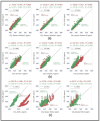Low-Cost CO2 NDIR Sensors: Performance Evaluation and Calibration Using Machine Learning Techniques
- PMID: 39275586
- PMCID: PMC11397870
- DOI: 10.3390/s24175675
Low-Cost CO2 NDIR Sensors: Performance Evaluation and Calibration Using Machine Learning Techniques
Abstract
The study comprehensively evaluates low-cost CO2 sensors from different price tiers, assessing their performance against a reference-grade instrument and exploring the possibility of calibration using different machine learning techniques. Three sensors (Sunrise AB by Senseair, K30 CO2 by Senseair, and GMP 343 by Vaisala) were tested alongside a reference instrument (Los Gatos precision greenhouse gas analyzer). The results revealed differences in sensor performance, with the higher cost Vaisala sensors exhibiting superior accuracy. Despite its lower price, the Sunrise sensors still demonstrated reasonable accuracy. Meanwhile, the K30 sensor measurements displayed higher variability and noise. Machine learning models, including linear regression, gradient boosting regression, and random forest regression, were employed for sensor calibration. In general, linear regression models performed best for extrapolating data, whereas decision tree-based models were generally more useful in handling non-linear datasets. Notably, a stack ensemble model combining these techniques outperformed the individual models and significantly improved sensor accuracy by approximately 65%. Overall, this study contributes to filling the gap in intercomparing CO2 sensors across different price categories and underscores the potential of machine learning for enhancing sensor accuracy, particularly in low-cost sensor applications.
Keywords: collocated measurements; low-cost CO2 sensors; machine learning calibration; performance evaluation.
Conflict of interest statement
The authors declare no conflicts of interest.
Figures







References
-
- Zhang Y., Lyu M., Yang P., Lai D.Y., Tong C., Zhao G., Li L., Zhang Y., Yang H. Spatial variations in CO2 fluxes in a subtropical coastal reservoir of Southeast China were related to urbanization and land-use types. J. Environ. Sci. (China) 2021;109:206–218. doi: 10.1016/j.jes.2021.04.003. - DOI - PubMed
-
- Lapierre J.-F., Seekell D.A., Filstrup C.T., Collins S.M., Fergus C.E., Soranno P.A., Cheruvelil K.S. Continental-scale variation in controls of summer CO2 in United States lakes. J. Geophys. Res. Biogeosci. 2017;122:875–885. doi: 10.1002/2016JG003525. - DOI
-
- Li Y., Zheng J., Dong S., Wen X., Jin X., Zhang L., Peng X. Temporal variations of local traffic CO2 emissions and its relationship with CO2 flux in Beijing, China. Transp. Res. Part D Transp. Environ. 2019;67:1–15. doi: 10.1016/j.trd.2018.10.007. - DOI
LinkOut - more resources
Full Text Sources
Miscellaneous

